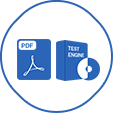Last Update 17 hours ago Total Questions : 164
The Artificial Intelligence Governance Professional content is now fully updated, with all current exam questions added 17 hours ago. Deciding to include AIGP practice exam questions in your study plan goes far beyond basic test preparation.
You'll find that our AIGP exam questions frequently feature detailed scenarios and practical problem-solving exercises that directly mirror industry challenges. Engaging with these AIGP sample sets allows you to effectively manage your time and pace yourself, giving you the ability to finish any Artificial Intelligence Governance Professional practice test comfortably within the allotted time.
Random forest algorithms are in what type of machine learning model?
The processes and methods that allow human users to understand and trust the outputs produced by AI are important in addressing which key regulatory concern?
Scenario:
An organization is developing a powerful general-purpose AI (GPAI) model that has systemic impact. The compliance team is assessing what legal obligations apply under the EU AI Act.
Under the EU AI Act, which of the following compliance actions applies only to General Purpose AI models with systemic risk?
Machine learning is best described as a type of algorithm by which?
Scenario:
A large multinational organization is rolling out a company-wide AI governance initiative. To build awareness and support adoption, they are evaluating different ways to train employees and stakeholders across departments, including legal, technical, marketing, and customer-facing roles.
Which of the following typical approaches is a large organization least likely to use to responsibly train stakeholders on AI terminology, strategy and governance?
CASE STUDY
A premier payroll services company that employs thousands of people globally, is embarking on a new hiring campaign and wants to implement policies and procedures to identify and retain the best talent. The new talent will help the company's product team expand its payroll offerings to companies in the healthcare and transportation sectors, including in Asia.
It has become time consuming and expensive for HR to review all resumes, and they are concerned that human reviewers might be susceptible to bias.
To address these concerns, the company is considering using a third-party Al tool to screen resumes and assist with hiring. They have been talking to several vendors about possibly obtaining a third-party Al-enabled hiring solution, as long as it would achieve its goals and comply with all applicable laws.
The organization has a large procurement team that is responsible for the contracting of technology solutions. One of the procurement team's goals is to reduce costs, and it often prefers lower-cost solutions. Others within the company deploy technology solutions into the organization’s operations in a responsible, cost-effective manner.
The organization is aware of the risks presented by Al hiring tools and wants to mitigate them. It also questions how best to organize and train its existing personnel to use the Al hiring tool responsibly. Their concerns are heightened by the fact that relevant laws vary across jurisdictions and continue to change.
All of the following are potential negative consequences created by using the AI tool to help make hiring decisions EXCEPT?
The OECD's Ethical Al Governance Framework is a self-regulation model that proposes to prevent societal harms by?

